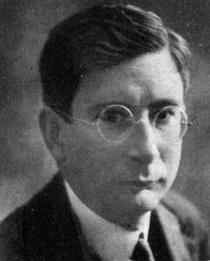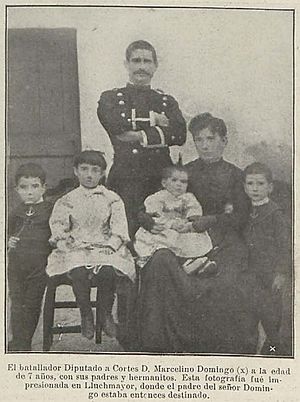Marcelino Domingo facts for kids
Quick facts for kids
Marcelino Domingo
|
|
|---|---|
|
Marcel·lí Domingo
|
|

Marcelino Domingo (1930)
|
|
| Personal details | |
| Born | 26 April 1884 Tortosa, Spain |
| Died | 2 March 1939 (aged 54) Toulouse, France |
| Political party | Catalan Republican Party Radical Socialist Republican Party |
| Other political affiliations |
Republican Left |
| Occupation | Politician, journalist, teacher |
Marcelino Domingo Sanjuán (born April 26, 1884 – died March 2, 1939) was an important Spanish teacher, journalist, and politician. He served as a minister many times during the time of the Second Spanish Republic.
Contents
Marcelino Domingo's Life and Work
Early Life and Start in Politics
Marcelino Domingo was born in Tarragona, Spain. He became a teacher in 1903. That same year, he moved to Tortosa. There, he started teaching and became involved with groups who supported a republic (a country led by elected officials, not a king). In Tortosa, he also managed a republican newspaper called El Pueblo.
His political journey began in 1909. He was chosen as a republican councillor for the Tortosa City Council. His influence grew when he joined the General Council of the Republican Nationalist Federal Union. He was later elected as a deputy (like a member of parliament) in the Cortes in the 1914 elections.
Domingo also worked as a journalist. He directed the Barcelona newspaper La Lucha. He also worked as an editor for another newspaper, La Publicidad. During a difficult time in Spain in 1917, he wrote a famous article. It was called "¿Qué espera el Rey?" (What is the King waiting for?). In it, he strongly criticized the monarchy (the system of government with a king or queen).
He became even more active in politics during the time of the Restoration and the dictatorship of Primo de Rivera. In 1915, he helped create a group called the Autonomist Republican Bloc. Two years later, he helped start the Catalan Republican Party. He was a key figure in the Assembly of Parliamentarians. He also helped prepare for the big 1917 Spanish general strike. This strike was led by groups like the PSOE and UGT.
Domingo strongly supported the idea of more self-rule for Catalonia. This idea was rejected by the Cortes in 1918. He also helped create a short-lived republican group called Left Alliance.
Marcelino Domingo and the Second Republic
In 1929, Marcelino Domingo helped create the Radical Socialist Republican Party. Later, in 1934, he joined with other leaders to form the Republican Left of Catalonia.
He was elected as a deputy for Barcelona in the 1931 general elections. He lost his seat in the 1933 elections but was elected again in the 1936 elections.
Marcelino Domingo served as the Minister of Public Instruction (which is like the Minister of Education) from April to December 1931. During his time as minister, he made important changes. He limited religious teaching in schools. He also allowed two languages to be used in schools in Catalonia. He started a plan to build many new schools across the country.
After this, he became the Minister of Agriculture. He held this position from December 1931 to June 1933, and again from June to September 1933. He returned to lead the Ministry of Public Instruction again from February to May 1936. This was during the first government of the Popular Front.
See also
 In Spanish: Marcelino Domingo para niños
In Spanish: Marcelino Domingo para niños


